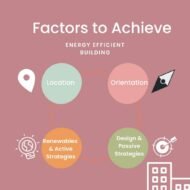Posted by Managementguru in Construction, Financial Management, How To, Real Estate Investment
on Sep 21st, 2023 | 0 comments

With their unique financial situations, entrepreneurs may encounter differences and challenges when obtaining a mortgage compared to traditional salaried individuals. However, with the right approach and preparation, entrepreneurs can secure a mortgage to purchase their dream home. With that in mind, here are some key steps and considerations for entrepreneurs looking to get mortgages. Documentation of Income One of the main challenges entrepreneurs face is demonstrating a consistent income to lenders. Unlike salaried individuals, entrepreneurs often have varying income sources, which can make it more difficult to prove their ability to repay a mortgage. It’s essential to provide thorough documentation of your income, including tax returns, profit and loss statements, and bank statements. Lenders typically assess your income over the past two years to determine your financial stability. Maintain Good Credit Your credit score is important in mortgage approval and the interest rate you’ll receive. Keep a close eye on your credit report, address any discrepancies, and work on improving your credit score if needed. A higher credit score should improve your chances of getting approved and securing more favorable terms. Debt-to-Income Ratio Lenders evaluate your debt-to-income (DTI) ratio, which compares any monthly debt payments to your monthly income. Keeping your DTI ratio low demonstrates your ability to manage your financial obligations. Pay off high-interest debts and avoid taking on new debt in the months leading up to your mortgage application. Organize Financial Records Having organized and up-to-date financial records is crucial. Lenders will want to see clear records of your business income, expenses, and taxes. Being able to present this information in a well-organized manner can help lenders understand your financial situation better. Seek Professional Advice Consider working with an experienced mortgage broker specializing in working with self-employed individuals. They can provide personalized guidance and connect you with lenders who are more flexible with their lending criteria. Then, choose mortgage lenders experienced in working with self-employed individuals and entrepreneurs. They will understand the unique financial complexities you face and can offer guidance on the best mortgage options for your situation. Show Consistency Demonstrate consistent income and business stability. Lenders often prefer entrepreneurs who have been running their businesses for a few years and have a steady income history. Consistency can instill confidence in lenders about your ability to continue making mortgage payments. Build a Healthy Savings A healthy savings account demonstrates your financial stability and ability to cover unexpected expenses. It can also serve as a great safety net in case your business experiences fluctuations in income. Consider a Larger Down Payment If you can gather together a larger down payment, it can improve your loan-to-value (LTV) ratio, which is the loan amount compared to the property’s value. A lower LTV ratio can lower your risk profile in the eyes of lenders and potentially lead to better terms. Get Pre-approved Before house hunting, get pre-approved for a mortgage. This shows sellers that you are a serious buyer and have taken the necessary steps to secure financing. Pre-approval also gives you a clear understanding of your budget, saving you time by focusing on homes within your price range. Provide a Detailed Business Plan & Be Transparent For entrepreneurs, presenting a detailed business plan can showcase your future earning potential and demonstrate your commitment to your business’s growth and success. Honesty and transparency are vital throughout the mortgage application process, but particularly when it comes to your business plan. Disclose all financial information accurately and answer any inquiries from lenders truthfully. In conclusion, entrepreneurs can secure mortgages by effectively showcasing their financial stability, income consistency, and responsible financial management. By understanding the unique challenges and requirements that come with self-employment,...

Posted by Managementguru in Construction, Financial Management, How To
on Jun 10th, 2023 | 0 comments

In an era of rising energy costs and growing environmental concerns, adopting eco-friendly practices at home is more crucial than ever. By making a few simple changes and incorporating energy-saving strategies, you can significantly reduce your carbon footprint and save money on utility bills. In this article, we will explore practical tips to make your home more eco-friendly and provide long-term financial benefits. Upgrade to Energy-Efficient Appliances Upgrading your appliances to more energy-efficient options is a great way to reduce your home’s energy consumption. While you may spend more initially to upgrade your appliances, it’s a great way to reduce your carbon footprint and also helps you save money in the long run. Look for appliances with Energy Star ratings, as they are designed to use less electricity without compromising performance. Replace older models with energy-efficient refrigerators, washing machines, dishwashers, and air conditioners to enjoy substantial energy savings. Optimize Home Insulation A well-insulated home can help to maintain temperature better, limiting the need for extreme cooling or heating, which can save you money and make your home more eco-friendly. Ensure your attic, walls and floor are insulated to avoid heat loss in winter, and heat gain in summer. Sealing gaps around windows and doors with weatherstripping or caulk also prevents drafts, improving overall energy efficiency. Consider installing double-glazed windows to enhance insulation further. Harness Natural Light Natural light is better for our well-being than harsh artificial light. Plus, it’s also more cost-effective and more energy efficient. So, throw open the curtains in the morning instead of reaching for the light switch. When artificial lighting is necessary, opt for energy-efficient LED bulbs. LED lights consume significantly less energy and have a longer lifespan compared to traditional incandescent bulbs. You may also want to consider installing smart lighting systems to ensure your lights are automatically off if you’re not in the room. These methods will help you lower your electricity consumption and create a more eco-friendly home. Smart Thermostats for Energy Efficiency A smart thermostat is a valuable addition to your energy-saving arsenal. These devices connect to your home’s heating and cooling systems, allowing you to optimize your temperature settings and save energy with a smart thermostat. You can take advantage of features such as programmable settings, learning capabilities, and remote access. This can help you set energy-saving temperature ranges, schedule adjustments based on your daily routine, and even control settings using voice commands. By reducing water consumption, you can save money and energy. Water Conservation Strategies When making your home a more eco-friendly space, you must consider your water consumption. Consider installing low-flow shower heads and faucets to reduce water usage without sacrificing water pressure. You may also want to look around for any leaky faucets or toilets. Anything that is leaking and wasting water should be rectified. It’ll prevent waste, save energy, and save you money on your bills too. Transforming your home into an energy-efficient and eco-friendly haven doesn’t have to be complicated. These five simple practices will benefit your wallet, while also contributing to a more sustainable...

Posted by Managementguru in Civil Engineering, Construction, Project Management
on May 11th, 2023 | 0 comments

Imagine yourself strolling through the streets of a bustling city, marveling at the towering skyscrapers, and the complex network of roads, bridges, and underground tunnels. Have you ever pondered the minds (and hands) behind the creation of such technological marvels? You may thank the arduous efforts of civil engineers for making cities habitable, productive, and visually beautiful. This article will explore the world of civil engineering in more detail. The Art and Science of Civil Engineering Civil engineering is a diverse field that combines science, mathematics, and creativity to design, build, and maintain various infrastructure projects. These projects include roads, bridges, buildings, dams, and even water supply systems. At the heart of civil engineering lies an innate desire to improve people’s quality of life by providing safe, efficient, and sustainable environments. There are many companies that make significant contributions to the field, like CDI, and they are who you should consult if you have a larger project. Engineering firms are involved in numerous large-scale projects, demonstrating a deep understanding of the intricate balance between functionality, aesthetics, and sustainability. Innovative Solutions for Modern Challenges As cities continue to expand, civil engineers face several challenges, such as the need for sustainable development, combating climate change, and managing the increasing population’s demands. Let’s explore some innovative solutions that civil engineers have come up with to tackle these challenges: Green Infrastructure: Green roofs, rain gardens, and permeable pavements are some examples of green infrastructure that help manage stormwater runoff, reduce the heat island effect, and promote biodiversity. These sustainable solutions also offer aesthetic appeal, making our cities more liveable and enjoyable. Earthquake-resistant Buildings In areas prone to seismic activity, civil engineers have designed buildings with innovative technologies such as base isolation and energy-dissipating devices. These systems allow structures to withstand ground shaking, ensuring people’s safety and minimizing property damage. Smart Transportation With the advent of autonomous vehicles and connected infrastructure, civil engineers are creating intelligent transport systems that reduce congestion, improve safety, and decrease greenhouse gas emissions. These innovations will revolutionize the way we commute, making our cities more accessible and efficient. The Role of Civil Engineering in Community Development Civil engineering is not just about constructing large-scale infrastructure; it also plays a vital role in community development. By designing and maintaining local amenities such as parks, schools, and hospitals, civil engineers contribute to the well-being of residents in urban and rural areas alike. Moreover, they work on projects like flood prevention and water treatment facilities to protect communities from natural disasters and ensure access to clean water. The Future of Civil Engineering The need for competent civil engineers is expected to increase as urbanization spreads around the globe. The methods used by civil engineers to plan and build infrastructure will continue to evolve as a result of technological developments such as virtual reality, artificial intelligence, and 3D printing. If civil engineers adopt these innovations and continue to evolve to suit the needs of modern cities, they will play a significant role in creating the society in which we...

Posted by Managementguru in Construction, How To
on Mar 9th, 2023 | 0 comments

The idea towards net zero building has become increasingly popular in recent years as we strive to lower the carbon footprint of our built environment. A net zero building is characterised by its ability to enerate the same amount of energy it consumes over a year, resulting in a net zero energy consumption. To achieve this, the building’s design and construction are optimised, renewable energy sources like solar panels and wind turbines are integrated, and energy-efficient technologies and materials are utilised. Continue to read and learn more about the net zero building concept, its benefits and strategies, why it is essential to move towards net zero, and how it contributes to a sustainable future. What is Net Zero Building Concept? Net zero building is a design and construction concept focused on balancing the energy a building consumes and the amount of renewable energy it generates. The goal towards net zero building is to produce as much renewable energy on-site as it consumes annually, resulting in zero net energy consumption from the grid. Net zero buildings are designed to be highly energy-efficient, using advanced technologies such as high-performance insulation, energy-efficient windows, efficient lighting and appliances, and renewable energy systems such as solar panels and geothermal heating and cooling systems. The buildings are also constructed to maximise natural light and ventilation, decreasing the need for artificial lighting and HVAC systems. The concept towards net zero building includes all buildings, from homes and offices to schools and hospitals. The idea is gaining popularity as more people become aware of the need to reduce greenhouse gas emissions and combat climate change. Net zero buildings are essential to transition to a more sustainable and carbon-neutral economy. Strategies and Benefits of Net Zero Building Some strategies for achieving net zero building include: 1. Passive Design: Implementing passive design strategies such as optimising the building’s orientation, maximising natural light and ventilation, and using high-performance insulation and windows can effectively decrease a building’s energy demand. 2. Energy-Efficient Systems: Net zero buildings use highly efficient heating, cooling, and lighting systems to minimise energy consumption. 3. Renewable Energy: Net zero buildings generate energy on-site using renewable energy sources like solar panels, wind turbines, or geothermal systems. 4. Energy Storage: Energy storage systems, like batteries or thermal storage, can help towards net zero buildings store an excess amount of energy generated during peak times for use during periods of low energy production. Net zero buildings generate as much energy as they consume, resulting in zero net energy consumption. The benefits of net zero buildings include: 1. Reduced Energy Costs: Net zero buildings rely on sustainable energy sources like wind turbines or solar panels, which can significantly reduce energy costs. 2. Lower Carbon Footprint: Net zero buildings produce fewer greenhouse gas emissions, which can help combat climate change. 3. Increased Resilience: Net zero buildings are designed to be more resilient to power outages and other disruptions in the energy supply chain. 4. Improved Indoor Air Quality: Net zero buildings often incorporate features like natural ventilation and air purification systems, which can improve indoor air quality. Net Zero Building Contributing Towards a Sustainable Future Net zero buildings are a crucial component of a sustainable future. These buildings are designed to minimise environmental impact and reduce energy consumption using energy-efficient design, high-performance building materials, and renewable energy sources. By producing as much energy as they consume over a year, the step towards net zero buildings helps to reduce reliance on fossil fuels and decrease greenhouse gas emissions. They also improve indoor air quality and environmentally friendly use materials, reducing the need to replace and dispose of building materials. Net zero buildings are an innovative...








